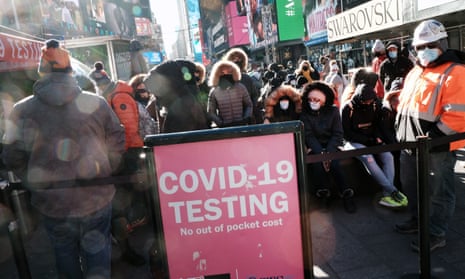Omicron is now the dominant version of the coronavirus in the US, federal health officials said on Monday, racing ahead of Delta and other variants and accounting for 73% of new infections last week.
The Centers for Disease Control and Prevention numbers showed nearly a six-fold increase in Omicron’s share of infections in only one week.
In much of the country, Omicron’s prevalence is even higher. It’s responsible for an estimated 90% of new infections in the New York area, the south-east, the industrial midwest and the Pacific north-west.
Since the end of June, the Delta variant has been the main version causing US infections. As recently as the end of November, more than 99.5% of coronaviruses were Delta, according to CDC data.
Scientists in Africa first sounded the alarm about Omicron less than a month ago and on 26 November the World Health Organization designated it as a “variant of concern”. The mutant has since shown up in about 90 countries.
Much about the Omicron variant remains unknown, including whether it causes more or less severe illness. Early studies suggest the vaccinated will need a booster shot for the best chance at preventing Omicron infection, but even without the extra dose, vaccination should offer strong protection against severe illness and death.
“All of us have a date with Omicron,” said Dr Amesh Adalja, a senior scholar at the Johns Hopkins Center for Health Security. “If you’re going to interact with society, if you’re going to have any type of life, Omicron will be something you encounter, and the best way you can encounter this is to be fully vaccinated.”
Adalja said he was not surprised by the CDC data showing Omicron overtaking Delta in the US, given what was seen in South Africa, the UK and Denmark. He predicted spread over the holidays, including breakthrough infections among the vaccinated and serious complications among the unvaccinated that could stress hospitals already burdened by Delta.
CDC’s estimates are based on thousands of coronavirus specimens collected each week through university and commercial laboratories and state and local health departments. Scientists analyze their genetic sequences to determine which versions of the Covid-19 viruses are most abundant.
In the week that ended 11 December, Omicron’s share of new infections in the US increased to 2.9% from 0.4% the week before, the CDC previously reported.
But CDC on Tuesday said it was revising some of the earlier numbers, after analyzing more specimens. The new numbers indicate that about 13% of the infections the week of 11 December were Omicron, and not 3%, CDC officials said.
